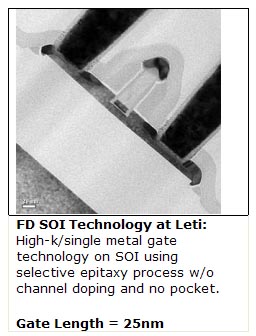Home > Press > Leti’s Planar-SOI Technology Meets Low-Power, 22nm Node Requirements, Supports Development of “Green” Products
 |
Abstract:
Leti, a leading global research center committed to creating and commercializing innovation in micro- and nanotechnologies, today presented results at the SOI Industry Consortium workshop in Leuven, Belgium, that prove SOI-based planar CMOS meets requirements for low-power, 22nm node devices, offering a practical route to further feature shrink and enabling a significant jump for "green" products.
Leti’s Planar-SOI Technology Meets Low-Power, 22nm Node Requirements, Supports Development of “Green” Products
Grenoble, France | Posted on October 16th, 2009With unmatched access resistance and electrostatic characteristics, planar SOI is superior to other technologies based on bulk CMOS technology and FinFET architecture. It also shows outstanding performances for low-power applications requiring 22nm technology, such as consumer electronic devices including 4G mobile phones.
"Many transistor architectures have been proposed for the 22nm node and below. At Leti, we favored planar technologies for faster and easier transition to manufacturing," said Laurent Malier, CEO of Leti. "Our recent results prove the strength of this approach. Together with the recent ARM results demonstrating power reduction on 45nm technology, we have proven that SOI technologies offer solutions for low power at a wide variety of nodes, including 22nm and below. Furthermore, we have demonstrated that planar SOI dramatically improves the energy performances of many products that will change our lives, while offering long-term success for many companies involved in these fast-growing markets.
In addition, drain-induced barrier lowering (DIBL) below 100mV/V has been demonstrated and SOI has been proven to enable the reduction of electrostatic parasitics.
While variability is a major challenge to be addressed for the 22nm node, Leti's results prove that variability control is possible with today's state-of-the-art SOI wafers. In particular, variability on threshold voltage was reduced by a factor of two compared with FinFET technologies, at wafer and batch levels.
Leti also showed that fully depleted SOI (FDSOI) CMOS can be scaled down to the 10nm node through tuning the buried oxide and silicon layer thickness. Displayed results show that FDSOI approach also addresses the variability issues for this further shrink.
####
About CEA-Leti
CEA is a French Research and Technology Organization, with activities in three main areas: Energy, Technologies for Information and Healthcare, and Defence and Security. Within CEA, the Laboratory for Electronics & Information Technology (CEA-Leti) works with companies in order to increase their competitiveness through technological innovation and transfers. Leti is focused on micro and nanotechnologies and their applications, from wireless devices and systems, to biology and healthcare or photonics. Nanoelectronics and Microsystems (MEMS) are at the core of its silicon activities. As a major player in the MINATEC® innovation campus, LETI operates 8,000-m² state-of-the-art clean rooms, on 24/7 mode, on 200mm and 300mm wafer standards. With 1,200 employees, Leti trains more than 150 Ph.D. students and hosts 200 assignees from partner companies. Strongly committed to the creation of value for the industry, Leti puts a strong emphasis on intellectual property and owns more than 1,400 patent families.
For more information, please click here
Contacts:
Clément Moulet, Press Officer
Tel.: +33 4 38 78 03 26
Copyright © CEA-Leti
If you have a comment, please Contact us.Issuers of news releases, not 7th Wave, Inc. or Nanotechnology Now, are solely responsible for the accuracy of the content.
| Related News Press |
Chip Technology
![]() Discovery points path to flash-like memory for storing qubits: Rice find could hasten development of nonvolatile quantum memory April 5th, 2024
Discovery points path to flash-like memory for storing qubits: Rice find could hasten development of nonvolatile quantum memory April 5th, 2024
![]() Utilizing palladium for addressing contact issues of buried oxide thin film transistors April 5th, 2024
Utilizing palladium for addressing contact issues of buried oxide thin film transistors April 5th, 2024
![]() HKUST researchers develop new integration technique for efficient coupling of III-V and silicon February 16th, 2024
HKUST researchers develop new integration technique for efficient coupling of III-V and silicon February 16th, 2024
Announcements
![]() NRL charters Navy’s quantum inertial navigation path to reduce drift April 5th, 2024
NRL charters Navy’s quantum inertial navigation path to reduce drift April 5th, 2024
![]() Discovery points path to flash-like memory for storing qubits: Rice find could hasten development of nonvolatile quantum memory April 5th, 2024
Discovery points path to flash-like memory for storing qubits: Rice find could hasten development of nonvolatile quantum memory April 5th, 2024
Environment
![]() Billions of nanoplastics released when microwaving baby food containers: Exposure to plastic particles kills up to 75% of cultured kidney cells July 21st, 2023
Billions of nanoplastics released when microwaving baby food containers: Exposure to plastic particles kills up to 75% of cultured kidney cells July 21st, 2023
Events/Classes
![]() Researchers demonstrate co-propagation of quantum and classical signals: Study shows that quantum encryption can be implemented in existing fiber networks January 20th, 2023
Researchers demonstrate co-propagation of quantum and classical signals: Study shows that quantum encryption can be implemented in existing fiber networks January 20th, 2023
|
|
||
|
|
||
| The latest news from around the world, FREE | ||
|
|
||
|
|
||
| Premium Products | ||
|
|
||
|
Only the news you want to read!
Learn More |
||
|
|
||
|
Full-service, expert consulting
Learn More |
||
|
|
||








